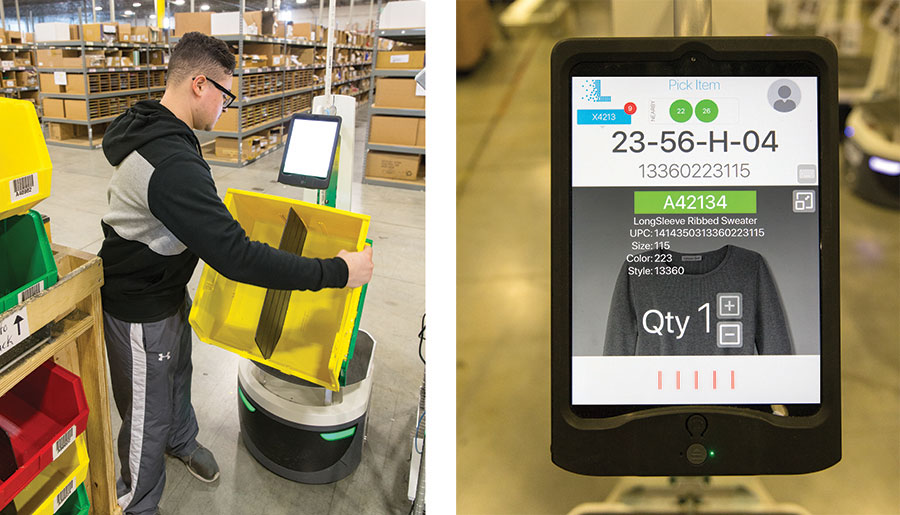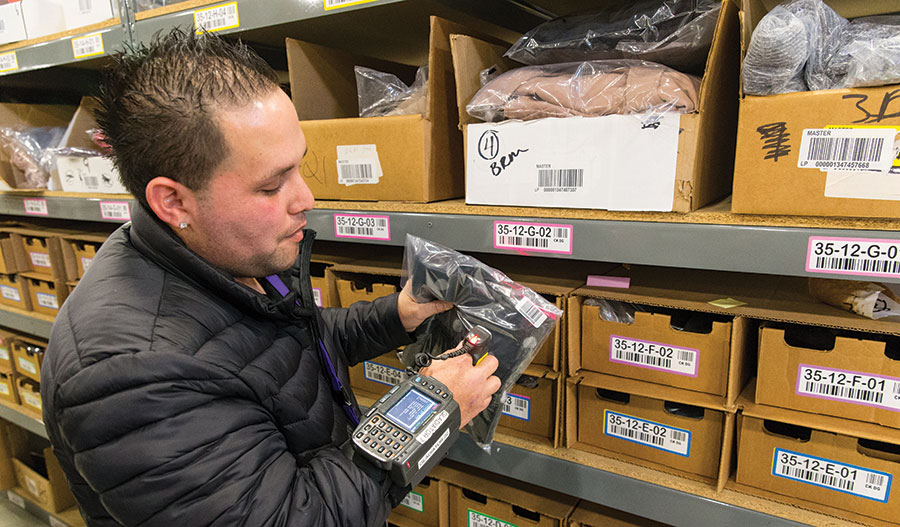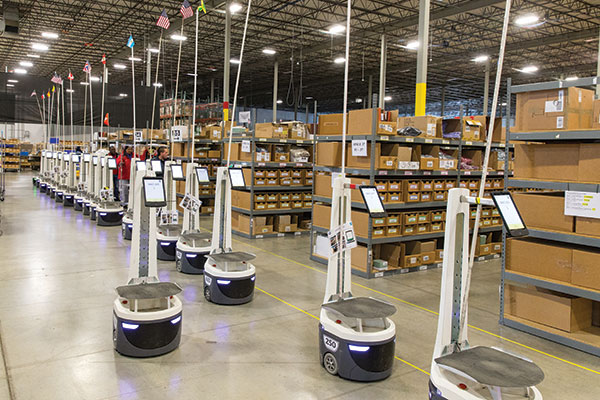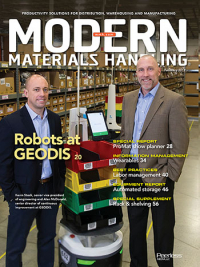Modern’s System Report: Robots at GEODIS
The global 3PL turned to mobile collaborative robots to rev up its e-commerce fulfillment operations. One measurableresult: a 2x improvement in productivity.
More than 6.5 million. That’s how many units GEODIS, the global third-party logistics (3PL) provider, had picked to a fleet of mobile collaborative robots (Locus Robotics, locusrobotics.com) as of mid-December 2018.
175 and counting. That’s the number of cobots GEODIS had deployed across its North American facilities as of that date.
2x. That’s the productivity improvements that GEODIS realized since it first deployed a fleet of 21 bots in a facility outside of Indianapolis in January 2018 following a three-month pilot, according to Alan McDonald, senior director of continuous improvement, and Kevin Stock, the senior vice president of engineering.
Learn more about how GEODIS implemented robotics to increase productivity and throughput.
Those are just some of the numbers that GEODIS believes make a compelling case for mobile collaborative robots in warehouse and distribution environments, like e-commerce, that involve a significant volume of each picks. In GEODIS’ case, the number of units picked during peak season increased 30% year over year. But it’s not just the drive for more productivity that led GEODIS to robotics. Customers are also demanding innovation.
“The market is definitely driving us to new technologies like robotics,” notes McDonald. “Our customers are asking us what innovations we are looking at for the future. In fact, not a week goes by that we don’t talk to an existing or potential customer who wants to know where we’re headed.”
Adds Stock: “Delivering on KPIs and costs are considered table stakes for a 3PL. Now, the question is: What else are you bringing to the table?”

For GEODIS, one of the answers to that question is mobile collaborative robots, which also help the global 3PL address the other big issue for warehousing and distribution operators: How do we staff a facility with reliable and productive associates at a time when more and more e-commerce facilities are opening in the same logistics hubs during record low unemployment?
“There is a lot of competition for associates in the areas where we have warehouses, so we have to make them a more desirable place to work,” Stock says. “We’re installing better breakrooms, better lighting and doing what we can to make the jobs easier to learn and perform successfully. Robotics is part of that.”
This is a look at how one of the world’s leading 3PLs chose and implemented a mobile collaborative robotics solution that it is now deploying across its footprint.
Investigating robots
With headquarters in Paris, GEODIS is one of the largest 3PLs in the world and generated more than $9.25 billion in revenue in 2017, the last year for which results are available. The company services 165,000 customers, with 40,500 employees across 120 countries and 70 million square feet of warehouse space. It moves more than 100 million parcels a year.
In the United States, GEODIS leverages 140 facilities on 20 campuses, representing 43 million square feet. It serves six defined verticals, including retail and e-commerce fulfillment, consumer electronics, fast-moving consumer goods, health care, industrial and automotive.
As with other 3PL providers, one of the key trends impacting the business is the growth of e-commerce fulfillment. “It’s not pallets and cases anymore,” says Stock. “The volume of e-commerce orders is soaring and that means a lot more touches and a lot more people in a very tight labor market.”

And, as with other 3PL providers, GEODIS is looking to technology to address those issues in an industry that historically eschewed automation in favor of best conventional warehousing processes. GEODIS has installed automated pick towers, conveyor and sortation systems, and put walls in some of its operations—and it is working on a project to use drones to take inventory in its facilities. But, in its e-commerce picking operations, it still relied heavily on conventional pick processes such as pick-to-cart enabled by wearable wrist units and a warehouse management system (WMS).
In early 2017, the 3PL concluded that conventional was no longer sustainable, according to McDonald. That spring, GEODIS put together an innovation team to investigate new technologies. Important criteria included: the capital investment required, was it user friendly and easy to operate, was it scalable and finally, was it mobile—if necessary, how easily could GEODIS move a solution from one facility to another?
That April, the new team went to ProMat 2017 to see what the industry had to offer. “We were deliberate about who we spoke to,” McDonald says, “and after we narrowed the solutions we were interested in down to collaborative robots, we narrowed that down to a few providers.”
Over the course of the summer, the innovation team visited sites where cobots were up and running; they visited company headquarters to learn more about the various providers and their cultures; and asked the potential providers to develop a business case. The fact that this is a new technology, and that many of the providers are startups, made the evaluation a different process than if GEODIS had been looking at a conventional, established automation solution.

“You not only want the right solution, you want the right provider,” says McDonald. “Vendors visited our site to demonstrate what they could do. More importantly, when we visited them on their home turf, we wanted to know what was on their road map. It was great that they could do something now, but we wanted to know what were their plans for the future. What was in development that they could tell us about?”
By the end of the summer, they had chosen a provider for a three-month-long pilot involving 21 bots. The deciding factors went beyond the solution. “Truthfully, we bounced back and forth between potential solution providers, but we chose the partner we chose because we not only liked their software, but there was a good cultural match between our companies, and they had the same vision as we did. The fact that they had experience in operations helped.”
Rolling out a solution
Implementing a new technology, especially one for which there isn’t a lot of use cases to learn from, is often a multi-step process. That was the case for GEODIS, although the technology proved itself fairly quickly.
It began with a planned three-month pilot program using 21 cobots in an Indianapolis e-commerce fulfillment center. They developed a process to batch pick single line orders to a tote that would then be sorted out at packing. “Once we selected a supplier, we did a deep dive, starting in October 2017,” says McDonald. “We compared pick rates to the existing cluster pick-to-cart process we were using in that operation.” Additionally, there was some software development for the interface between the GEODIS WMS and the robotic control system, along with some modifications to the pack operation.
GEODIS quickly learned that in addition to productivity improvements, soft benefits needed to be factored into the decision. For one, the training time to get an associate up and running with a cobot was quicker than learning how to pick to cart. They were easy to operate. Today, the cobots can communicate in the four languages most common to the facility: English, Spanish, Burmese and Chin, which is a language spoken predominantly in Myanmar. For another, associates liked working with the cobots, which they were encouraged to name during the pilot.
“If you watch some of our videos online, our operators say they often talk to the bots,” McDonald says. “So, while productivity was an important metric, we also considered the engagement of employees and the fact that we could make a mundane task more interesting. That leads to better retention.”
Another soft benefit that could not be counted out: customer satisfaction. “When our customers ask us what we’re doing with technology, we can point to the robots,” McDonald says.
In early January 2018, GEODIS formally transitioned from pilot to go live. During that period, communication was important: It was important that the whole team, and not just order selectors, understand their jobs were not threatened. “We held meetings for all of our operators, whether they would interface with a robot or not,” says Stock. “The important word was: collaborative. We made sure our operators knew that a bot was not going to pick the product, so this was about enabling our people to be more productive while making their jobs easier. It wasn’t about replacing people.”
At the facility level, there have been ongoing learnings over the last year, as GEODIS works with the cobots. “It’s very easy to learn to pick to the bots. It’s longer to learn how to operate them,” says McDonald. “The more you work with them, the more you learn about what kind of robot-to-operator ratio you need based on the volume of orders.” At present, GEODIS uses between three and six bots per associate, depending on the volume and density of orders to be picked in a given day.
The new business model
 Automation-as-a-service is one of the emerging business models in the materials handling automation space. In this model, a solution provider owns, maintains and in some cases, even operates, the equipment or an entire automated warehouse for a fee. The cost is often on a per-pallet, per-case or per-pick basis.
Automation-as-a-service is one of the emerging business models in the materials handling automation space. In this model, a solution provider owns, maintains and in some cases, even operates, the equipment or an entire automated warehouse for a fee. The cost is often on a per-pallet, per-case or per-pick basis.
That includes robotics. Typically two or three options are available, similar to the lift truck industry. They include a purchase option; purchase and rental option, where you purchase a baseline fleet and then rent additional robots on an as needed basis, such as peak and a robot-as-a-service model in which you pay a price based on how the robot is operated, such as a cost per pick.
In this instance, GEODIS chose the service model, which is less capital intensive than a purchase option. “It’s a very competitive market right now, and we spoke to multiple providers who were offering a robotics-as-a-service model,” says Alan McDonald, GEODIS senior director of continuous improvement. “I think they all know they need to make it as easy as they can for people to adopt the technology.”
In addition to productivity improvements and customer satisfaction, cobots are easy to implement compared to other technologies. A new robot can be received, unpacked and in operation in a matter of hours. Similarly, an associate—or an office employee helping out on the floor during peak—can be picking very quickly. Finally, for the distribution team, it’s exciting to be on the leading edge of an emerging technology.
“There is a perception that I think is accurate that GEODIS is on the front line of this technology,” says McDonald. “If we were to wait until the technology matures to adopt it, we’d be behind the curve.”
Adds Stock: “We want to be on the cutting edge, and as a result, we’re creating new opportunities for our business, and for the people who work for us.”
Learn more about how GEODIS implemented robotics to increase productivity and throughput.

Article Topics
Robotics News & Resources
Materials Handling Robotics: The new world of heterogeneous robotic integration Walmart deploying autonomous lift trucks at four of its high-tech DCs 2024 Intralogistics Robotics Survey: Robot demand surges Autonomous mobile robots (AMRs) on a mission Up close and personal with mind twisting special purpose robots Gartner foresees sizeable uptake for next-gen humanoid robots A3 bestows Joseph F. Engelberger Robotics Awards to three industry leaders More RoboticsLatest in Materials Handling
Registration open for Pack Expo International 2024 Walmart chooses Swisslog AS/RS and software for third milk processing facility NetLogistik partners with Vuzix subsidiary Moviynt to offer mobility solutions for warehouses Materials Handling Robotics: The new world of heterogeneous robotic integration BSLBATT is looking for new distributors and resellers worldwide Lucas Watson appointed CSO for Körber’s Parcel Logistics business in North America Hyster recognizes Dealers of Distinction for 2023 More Materials HandlingAbout the Author
Subscribe to Materials Handling Magazine

Find out what the world's most innovative companies are doing to improve productivity in their plants and distribution centers.
Start your FREE subscription today.
April 2024 Modern Materials Handling

Latest Resources












